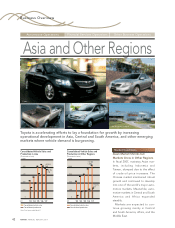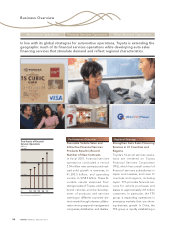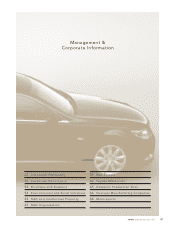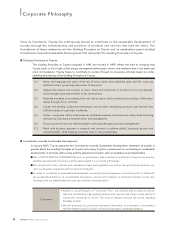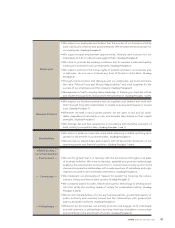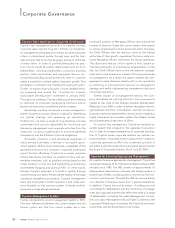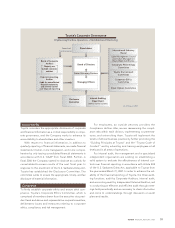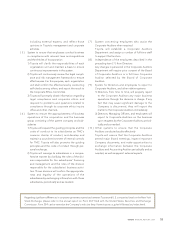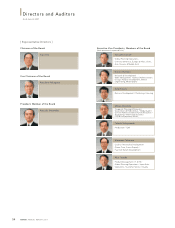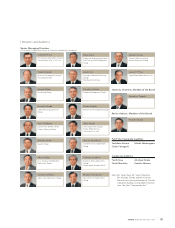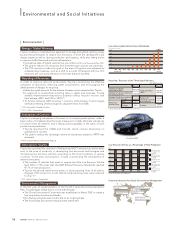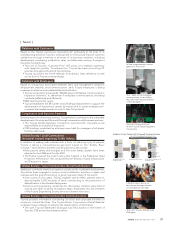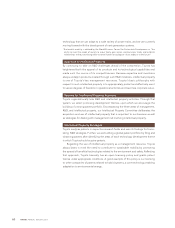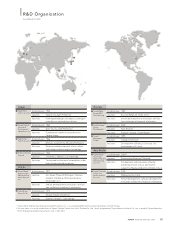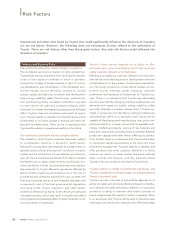Toyota 2007 Annual Report Download - page 54
Download and view the complete annual report
Please find page 54 of the 2007 Toyota annual report below. You can navigate through the pages in the report by either clicking on the pages listed below, or by using the keyword search tool below to find specific information within the annual report.
52 ANNUAL REPORT 2007
Corporate Social Responsibility
To maintain stable, long-term growth in international soci-
ety, companies have to earn the respect and trust of society
and individuals. Rather than simply contributing to eco-
nomic development through operational activities, growing
in harmony with society is a must for good corporate citi-
zens. Mindful of the foregoing, Toyota has a range of com-
mittees that are tasked with monitoring corporate activities
and management in relation to social responsibilities,
including the Corporate Philanthropy Committee and the
Toyota Environment Committee.
Internal Control Systems and Toyota’s Basic Approach
Based on the “Guiding Principles at Toyota” and the
“Toyota Code of Conduct,” we, together with our sub-
sidiaries, have created and maintained a sound corporate
culture. In our actual operations, we integrate into our busi-
ness operation processes the principles of problems identi-
fication (“Mondai Hakken”) and continuous improvements
(“Kaizen”) and make continuous efforts to train our employ-
ees who put these principles into practice.
With the above understanding, internal control has
been developed under the following basic policies.
[ 1 ] System to ensure that the Directors execute their
responsibilities in compliance with relevant laws and
regulations and the Articles of Incorporation
1) Toyota will ensure that Directors act in compliance
with relevant laws and regulations and the Articles
of Incorporation, based on the Code of Ethics and
other explanatory documents that include neces-
sary legal information, presented on occasions
such as trainings for new Directors.
2) Toyota will make decisions regarding business
operations after comprehensive discussions at the
Board meetings and other meetings of various
cross-sectional decision-making bodies. Matters to
be decided are properly submitted and discussed
at the meetings of those decision-making bodies in
accordance with the relevant rules.
3) Toyota will appropriately discuss significant matters
and measures relating to issues such as corporate
ethics, compliance, and risk management at the
Corporate Ethics Committee and other meetings.
Toyota will also discuss and decide at the meetings
of various cross-sectional decision-making bodies
policies and systems to monitor and respond to
risks relating to organizational function.
[ 2 ] System to retain and manage information relating to
performance of duties by Directors
Information relating to exercising duties by Directors
shall be appropriately retained and managed by each
division in charge pursuant to the relevant internal
rules and laws and regulations.
[ 3 ] Rules and systems related to the management of risk
of loss
1) Toyota will properly manage the capital fund
through its budgeting system and other forms of
control, conduct business operations, and manage
the budget, based on the authorities and responsi-
bilities in accordance with the “Ringi” system
(effective consensus-building and approval system).
Significant matters will be properly submitted and
discussed at the Board meetings and other meet-
ings of various bodies in accordance with the stan-
dards stipulated in the relevant rules.
2) Toyota will ensure accurate financial reporting by
issuing documentation on the financial flow and
the control system etc., and by properly and
promptly disclosing information through the
Disclosure Committee.
3) Toyota will manage various risks relating to safety,
quality, the environment and compliance by estab-
lishing rules or preparing and delivering manuals,
as necessary, in each relevant division.
4) As a precaution against events such as natural dis-
asters, Toyota will prepare manuals, conduct emer-
gency drills, arrange risk diversification and
insurance as needed.
[ 4 ] System to ensure that Directors exercise their duties
efficiently
1) Toyota will manage consistent policies by specify-
ing the policies at each level of the organization
based on the medium- to long-term management
policies and the Company’s policies for each fiscal
term.
2) The Chief Officer, as a liaising officer between the
management and operational functions, will direct
and supervise Managing Officers based on the
management policies and delegate the executive
authority over each division to the Managing
Officers so that flexible and timely decision making
can be achieved.
3) Toyota from time to time will make opportunities to
listen to the opinions of various stakeholders,


